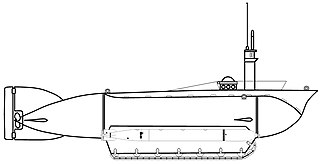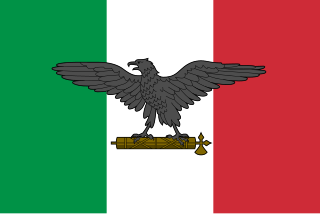
The Kriegsmarine was the navy of Nazi Germany from 1935 to 1945. It superseded the Imperial German Navy of the German Empire (1871–1918) and the inter-war Reichsmarine (1919–1935) of the Weimar Republic. The Kriegsmarine was one of three official branches, along with the Heer and the Luftwaffe, of the Wehrmacht, the German armed forces from 1935 to 1945.

A midget submarine is any submarine under 150 tons, typically operated by a crew of one or two but sometimes up to six or nine, with little or no on-board living accommodation. They normally work with mother ships, from which they are launched and recovered and which provide living accommodation for the crew and support staff.

Human torpedoes or manned torpedoes are a type of diver propulsion vehicle on which the diver rides, generally in a seated position behind a fairing. They were used as secret naval weapons in World War II. The basic concept is still in use.
German submarine U-219 was a Type XB submarine of Nazi Germany's Kriegsmarine during World War II. The U-boat was laid down on 31 May 1941 at the Germaniawerft yard at Kiel as yard number 625, launched on 6 October 1942, and commissioned on 12 December 1942 under the command of Korvettenkapitän Walter Burghagen.

Seeteufel was a two-man amphibious midget submarine, developed by Nazi Germany during World War II. Only one prototype was built in 1944, although its testing was relatively successful and negotiations began for another series of three to test the necessary changes before beginning series production in 1945. These plans were cancelled at the beginning of that year when the decision was made to concentrate production on designs already being built.
I-29, code-named Matsu, was a B1 type submarine of the Imperial Japanese Navy used during World War II on two secret missions with Germany. She was sunk while returning from the second mission.

Biber was a German midget submarine of the Second World War. Armed with two externally mounted 53-centimetre (21 in) torpedoes or mines, they were intended to attack coastal shipping. They were among the smallest submarines in the Kriegsmarine.
Seehund, also known as Type XXVII, was a midget submarine built by Nazi Germany during World War II. Designed in 1944 and operated by two-man crews, it was used by the Kriegsmarine during the closing months of the war, sinking nine merchant vessels and damaging an additional three, while losing 35 boats, mostly attributed to bad weather. The French Navy used four captured boats after the war until 1953.

Molch was an unsuccessful series of one-man midget submarines created during World War II. Built in 1944, it was the first mini-submarine of Nazi Germany's Kriegsmarine, but was not successful in combat operations and suffered heavy losses.

Delphin (dolphin) was a midget submarine created during World War II. Designed in 1944, only three prototypes were created by Nazi Germany's Kriegsmarine by the end of the war, all of which were destroyed. The Delphin was built for underwater speed attacks, as German engineers under the leadership of Ulrich Gabler discovered that past midget submarines were too slow to match the speeds of large ships in the English Channel.

HMS Sea Nymph was a S-class submarine of the third batch built for the Royal Navy during World War II. Completed in July 1942, she spent the majority of her career patrolling the waters off Norway in the North Sea, then was sent to the Pacific but was forced back due to technical problems.
The Black Sea Campaigns were the operations of the Axis and Soviet naval forces in the Black Sea and its coastal regions during World War II between 1941 and 1944, including in support of the land forces.

A deck gun is a type of naval artillery mounted on the deck of a submarine. Most submarine deck guns were open, with or without a shield; however, a few larger submarines placed these guns in a turret.

USS PC-558 was a PC-461-class submarine chaser built for the United States Navy during World War II. She was sunk by German submarine U-230 on 9 May 1944 with the loss of about half of her complement; there were 30 survivors.

German submarine U-1224 was a Type IXC/40 U-boat of Nazi Germany's Kriegsmarine built for service during World War II. She was constructed by Deutsche Werft of Hamburg, and was commissioned on 20 October 1943, with Kapitänleutnant Georg Preuss in command. She was assigned to the 31st U-boat Flotilla, a submarine training unit.
German submarine U-212 was a Type VIIC U-boat that served with the Kriegsmarine during World War II. Laid down on 17 May 1941 as yard number 641 at F. Krupp Germaniawerft in Kiel, she was launched on 11 March 1942 and commissioned on 25 April under the command of Oberleutnant zur See Helmut Vogler.

A coastal submarine or littoral submarine is a small, maneuverable submarine with shallow draft well suited to navigation of coastal channels and harbors. Although size is not precisely defined, coastal submarines are larger than midget submarines, but smaller than sea-going submarines designed for longer patrols on the open ocean. Space limitations aboard coastal submarines restrict fuel availability for distant travel, food availability for extended patrol duration, and number of weapons carried. Within those limitations, however, coastal submarines may be able to reach areas inaccessible to larger submarines, and be more difficult to detect.

The National Republican Navy was the navy of the Italian Social Republic, a World War II German puppet state in Italy.













